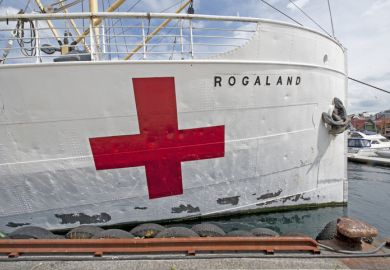Gina Kolata set herself a challenging task: to breathe life into an almost-forgotten virus from 1918 and to set it in a modern context. She succeeds in both because the events she describes are so dramatic and because she tells her story so well.
The influenza virus arose towards the end of the first world war and quietly killed 50 million people worldwide in 18 months - more than the war itself. The breathtakingly sensitive techniques of molecular biology can now be used to locate and rebuild the virus. They are being applied to samples taken from the frozen brains of flu victims who died in Spitsbergen in 1918: their permafrost graves have been exhumed by groups of competing scientists, including my own, searching the arid wastes of the Arctic with pickaxes.
From our modern perspective, the HIV outbreak looks lethargic and almost trivial compared with the 1918 Spanish influenza pandemic. Even bubonic plague, the Black Death of the Middle Ages, pales in comparison to the "Spanish Lady".
Kolata jumps straight in at the end of the war. It is a good beginning, if a little too United States-orientated. She recreates a perhaps unique scenario of social and medical history by consulting the biographies of eminent physicians and epidemiologists of the time, such as William Welch and Victor Vaughan, who visited afflicted army camps in the US. She finds that hardly anything was written by them about influenza.
Alfred Crosby in his earlier book called the 1918 calamity The Forgotten Plague , and I feel this is true. At the Cenotaph in London each year we gather to remember the great war. I go to remember my father who was a survivor of both the war and the flu that followed it. Perhaps we should have a national memorial to the great pandemic too. There must have been a million acts of heroism in the homes of families in every country, as husbands and wives struggled to keep each other alive, both knowing the inherent dangers of infection. In fact, many couples died, as Kolata touchingly details.
The book has sparkling pen portraits of scientists. My old and even young colleagues are there with their personalities on view: Ed Kilbourne, Peter Palese ("pale blue eyes and wire-rimmed glasses"), Ken Shortridge and Geoffrey Taubenberger ("boyish-faced leader of the group").
But sometimes in the plethora of characters the scientific thread gets lost. I feel the author could have defined the scientific objectives of studying the 1918 virus more clearly.
For example, the book devotes a chapter to bird flu in Hong Kong in 1997 (in which thousands of chickens had to be slaughtered), but does not give a strong enough scientific background to enable the reader to link this recent event with the events of 1918. Similarly, many will ask why the book digresses into the swine influenza outbreak at Fort Dix, US, in 1976.
My own aim in studying the 1918 virus is to identify a motif, or piece, of one of its eight genes that could be used to identify and tag future pandemic viruses. I know that Taubenberger and Ann Reid have the same objective.
I must confess that when I first received the book, I was worried I would be portrayed as a member of the awkward squad or as a mad scientist running around in an Arctic fox hat. I know my weaknesses, I believe, and I actually escape lightly. There is no doubt that it is Johan Hultin who is the book's hero, followed closely by Taubenberger. And quite rightly so. Hultin pioneered the approach of searching for frozen 1918 victims and initiated the first and third expeditions to the Arctic. In the early 1950s, he exhumed several persons in Alaska while looking for infectious virus in lung tissue and found nothing. Now in his mid-seventies, on a recent revisit to the same Arctic site, he still dug the permafrost himself. I know what it feels like: the pick descends and bounces off the earth, as if it were made of concrete.
Taubenberger manipulated the methods of extraction of viral RNA and the subsequent polymerase chain reaction to their limit, and constructed the nucleotide trees that enabled the first comparison of 1918 influenza with the virus strains we know from the 1930s. He showed the 1918 virus to be "human" rather than "avian", and raised the first caution that we may not after all be able to reach our goal of a virulence motif. Mutations may be scattered over all eight genes of the virus, in which case very subtle interactions could have enhanced the virulence. Perhaps the virus itself was not especially virulent, but its spread was facilitated by demobilisation and the dramatic events at the end of the war.
I would have liked a chapter on "Could it happen again?" Surprisingly, a recent report from the US has estimated that should a new influenza pandemic arise in the next few years almost as many Americans could die as in 1918! We have three new anti-flu drugs, antibiotics to treat secondary lung infections and an increased number of vaccine doses - but our old enemy influenza, the major killer virus of the 20th century, could still hit us extremely hard.
I already knew the life story of Hultin, because he told me all about it one day in my London garden, early in the summer of our own expedition to Spitsbergen. This expedition comes off a little badly in the book. The team leader, Kirsty Duncan, says it was an unpleasant experience. I would not go as far as this, and we now have had good news that was discovered too late to be included in the book. A key member of the team, Rod Daniels, has found influenza 1918 RNA in respiratory tissue and also in the brain of some of the Spitsbergen coal miners. We are trying to fathom the meaning of this. Could it be a piece in the jigsaw linking pandemic influenza to the ensuing outbreak of encephalitis lethargica , the sleeping disease so evocatively portrayed in the film Awakenings? All the best scientific projects answer some questions but raise lots more.
We could fill a library with books about the great war. Not so the great pandemic. Katherine Ann Porter's Pale Horse, Pale Rider is a minor classic, the story of her own experience in 1918. Kolata's book can safely be shelved alongside both Porter and Crosby. She brilliantly captures the human face of scientific endeavour, where people are sometimes at odds with each other but are nevertheless aiming for a common goal. Scientists, virologists and pathologists are not ivory-tower characters. We quarrel, overeat, travel the world at other people's expense, and are swept off our feet by beauty both scientific and human. Kolata sees all this, and also makes the reader realise that to discover the genetic nature of 1918 virus would be a scientific treasure. She likens the finding of the viral nucleotide sequences to that of the decipherment of the Rosetta stone. I cannot disagree.
John S. Oxford is professor of virology, St Bartholomew's Hospital and the Royal London School of Medicine and Dentistry.
Flu: The Story of the Great Influenza Pandemic of 1918
Author - Gina Kolata
ISBN - 0 333 75105 1
Publisher - Macmillan
Price - £12.99
Pages - 330
Register to continue
Why register?
- Registration is free and only takes a moment
- Once registered, you can read 3 articles a month
- Sign up for our newsletter
Subscribe
Or subscribe for unlimited access to:
- Unlimited access to news, views, insights & reviews
- Digital editions
- Digital access to THE’s university and college rankings analysis
Already registered or a current subscriber? Login



